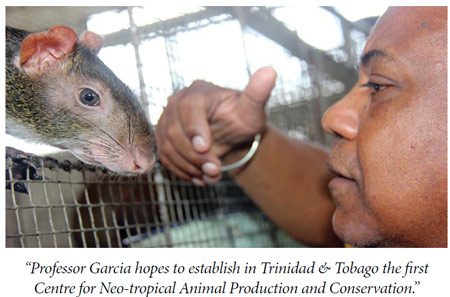
 Agouti, lappe, deer, manicou, wild hog and iguana: each name undoubtedly evokes a different image depending on whether you’ve eaten Trinidad & Tobago wild meat or not. Like it or not, wild meat forms a major part of Trinidad & Tobago’s cultural culinary landscape. Agouti, lappe, deer, manicou, wild hog and iguana: each name undoubtedly evokes a different image depending on whether you’ve eaten Trinidad & Tobago wild meat or not. Like it or not, wild meat forms a major part of Trinidad & Tobago’s cultural culinary landscape.
Classified as “Neo Tropical” animals, the demand has been steadily growing and there is the belief that commercial wild meat production has immense economic potential since Trinidad & Tobago leads the way in Neo-tropical Animal Conservation, Management, Production and Utilization in the Caribbean. Professor Gary Wayne Garcia is one who holds that belief.
In 1992 Professor Garcia began his study of the natural fauna that lives not only in Trinidad & Tobago, but also in the surrounding Caribbean and Latin American countries. Along the way he developed a high level of understanding about these animals and the threats that exist to their long-term survival due to human pressures. In his Professorial Inaugural Lecture, he outlined how the wild/non-domestic (neo-tropical) animals in Trinidad & Tobago’s backyards and natural environments became the motive force and transportation mechanism for his professorial journey. He summarised important and novel outcomes from this knowledge acquisition adventure.
The first outcome was the establishment of the largest Agouti (Dasyprocta leporina) production unit for scientific purposes, since 1996, initially self financed and now operationally supported by students and On the Job Trainees. Located at the Wildlife Unit at The University Field Station, it houses a living collection of seven Agouti (Dasyprocta leporina) genotypes [white, brown, black, gold, brown with a golden rump, white with a golden rump and brown with white feet] thus challenging the existence of 11 species within the Dasyprocta genus.
He later developed “A Conceptual Framework for the development of Intensive Production Models for Neo-tropical animals” [1998] and the establishment of the “Open School of Tropical Animal Science and Production” [2001]. His Intensive Agouti (Dasyprocta leporina) production model revealed the following:
- Females began to cycle about 15-23 days after giving birth and while milking or lactating
- There were 3 parturitions/annum [a parturition interval of about 127 days]
- Up to 3 live offspring per litter
- While litter sizes were up to 5, only 3 survived
- All 8 mammary glands were functional
- Year round breeding
This work also reported the first method for live semen collection and evaluation from the male Agouti (Dasyprocta leporina), the pioneering of Agouti (Dasyprocta leporina) semen preservation techniques and the pioneering efforts to train the male Agouti (Dasyprocta leporina) for live semen collection without sedation. An award of a Ph.D. in Livestock Science by The UWI to Dr William Martin Mollineau, under the supervision of Professor Garcia and Professor Andrew Adogwa from the School of Veterinary Medicine, was a fitting culmination to this research.
Professor Garcia has suggested a sustainable way forward for “Animal Production in the Caribbean”, linking conventional domestic animal and food crop production systems with neo-tropical animal production, involving the need to develop harmony between neo-tropical animal wildlife conservation, management, production and utilization.
- Matching the Animals with the Available Feed Resources (Thomas Reginald Preston; pdf)
- Matching the Available Animals (including Neo-tropical Animals) with the Available Feed Resources (Gary Wayne Garcia)
The packed audience at his professorial lecture learnt that his international network assisted in the establishment of a semi-commercial Collared Peccary [Tayassu tajuca/Tayassu pecari] production unit in Santa Cruz, Trinidad & Tobago, with financial support from the French Government through INRA Antilles-Guyane. This collaboration helped in the establishment of 5 semi-commercial Collared Peccary [Tayassu tajuca/Tayassu pecari] production units in French Guyana.
His commitment to the indigenous fauna of Latin America and the Caribbean led to collaboration with CXC and CAPE and the eventual introduction of “Neo-tropical Animals and Neo-tropical Animal Production” into the CXC School Syllabus; it also resulted in a BA in Agricultural Education Programme at the University of Trinidad and Tobago (UTT). Further, he established working and publishing collaborative linkages with colleagues researching Neo-tropical Animals in Latin America such as EMBRAPA (Belem, Brazil), Universidade Estadual de Santa Cruz (Bahia, Brazil), Universidade Federal do Para (Para, Brazil), University of Suriname, INRA (Martinique, Guadeloupe and French Guyana) and Iquitos (Peru). It was because of his vast experience, expertise and prior educational collaboration with the South Eastern Hunters Association that Professor Garcia contributed on behalf of The UWI, in the Consultation on the Draft Wildlife Bill.
Last May in Argentina he made a pitch, entirely in Spanish, for The UWI to host the 11th Conference on Amazonian Wildlife (XI CIMFAUNA) in August 2014. The unanimous vote of approval means that, for the first time since its inception in 1992, this hemispheric conference will be held outside of Central and South America. In effect, this conference will serve to position Trinidad & Tobago as the leaders in wildlife production for food security and as a conservation tool.
Professor Garcia hopes to establish in Trinidad & Tobago the first Centre for Neo-tropical Animal Production and Conservation.
Professor Gary Garcia teaches courses in Livestock Products Technology and Tropical Animal Science in the Faculty of Food and Agriculture and in the School of Veterinary Medicine, UWI. He has produced books on the Agouti and the Collared Peccary, which were self published courtesy of The UWI Credit Union.
Professor Garcia’s Lecture, “From Wild to Semi-domesticated: Neo-tropical Animals and a Professorial Journey”, on May 16, ended the Professorial Inaugural Lecture Series at The UWI St. Augustine for the academic year 2012-2013. The series resumes in the new academic year in September.
Christine Nanton, who has a degree in Media & Communications from The UWI Mona, is a Marketing & Communications Officer at the St. Augustine Campus.
Photo: Aneel Karim |





